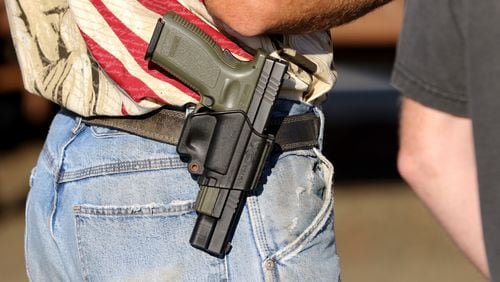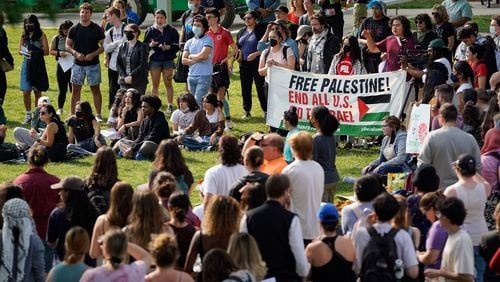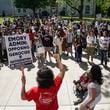After meeting Wednesday with student survivors and parents of teens killed in last week’s shooting spree at a Florida high school, President Donald Trump endorsed the idea of arming teachers.
"If you had a teacher who was adept with the firearm, they could end the attack very quickly," he said today. "This would be obviously only for people who were very adept at handling a gun, and it would be, it's called concealed carry, where a teacher would have a concealed gun on them. They'd go for special training and they would be there and you would no longer have a gun-free zone.”
Critics countered student shooters are not daunted by fears of meeting an armed response; Many, like the two Columbine killers, were on a suicide mission and planned to die. The Columbine shooters left video farewells for their parents.
With all this discussion about arming teachers, I spent a few hours looking at research on the accuracy rates of trained police officers in situations with active shooters.
What became clear: Accuracy with a firearm depends on training – and the police training is far more extensive, comprehensive and ongoing than anything that would ever be provided for teachers, including scenario practices.
And the training is not just in how to use a weapon but how to manage stress in a deadly situation. This is not something that can be mastered in a three-day or three-week class.
Yet, even with all of their training, it’s hard for police officers to hit a target and harder still in chaotic conditions.
The New York Police Department is the nation’s largest police force and among the best trained, yet its own study showed between 1998 and 2006, the average hit rate was 18 percent for officers in a gunfight.
Here are some of the interesting research findings I found with source links after each one so you can read the stuff:
The primary purpose of the study was to investigate the effectiveness of academy firearms training, as well as the accuracy of individuals without any handgun firearms experience or training. The results of this study demonstrated that individuals who had completed standard, law enforcement academy firearms training were not more accurate in their shooting than those who had not had any law enforcement handgun training. As well, they were only moderately more accurate than individuals who had minimal firearms and little to no handgun experience …this study's results indicate an alarming need for improved firearms training for officers. Further investigation is suggested to examine the possibility of a skill transfer in weapon manipulation between long-barrel firearms and handguns as well as officer accuracy under combat shooting conditions. The New York Police Department (NYPD) reported an 18-20% degradation of accuracy skills once an officer becomes involved in an actual gunfight (Vila and Morrison, 1994). This suggests that such motor skills are subject to degradation during levels of high stress.
New York City police statistics show that simply hitting a target, let alone hitting it in a specific spot, is a difficult challenge. In 2006, in cases where police officers intentionally fired a gun at a person, they discharged 364 bullets and hit their target 103 times, for a hit rate of 28.3 percent, according to the department’s Firearms Discharge Report. The police shot and killed 13 people last year.
In 2005, officers fired 472 times in the same circumstances, hitting their mark 82 times, for a 17.4 percent hit rate. They shot and killed nine people that year.
Bad marksmanship? Police officials and law enforcement experts say no, contending that the number of misses underscores the tense and unpredictable nature of these situations. For example, a 43 percent hit rate for shots fired from zero to six feet might seem low, but at that range it is very likely that something has already gone wrong: perhaps an officer got surprised, or had no cover, or was wrestling with the suspect.
The NYPD reports hit-rate statistics both for officers involved in a gunfight and for officers who shoot at subjects who do not return fire. Between 1998 and 2006, the average hit rate was 18 percent for gunfights. Between 1998 and 2006, the average hit rate in situations in which fire was not returned was 30 percent.
Accuracy improves at close range, with officers hitting their targets 37 percent of the time at distances of seven yards or less; at longer ranges, hit rates fall off sharply, to 23 percent.
About one-quarter of all accidental discharges occur while officers are “struggling with a subject.
The National Association of School Resource officers opposes arming teachers, sending out a a list of its reasons today:
1. Law enforcement officers who respond to an incident at a school could mistake for an assailant a teacher or any other armed person who is not in a uniform.
2. Anyone who hasn’t received the extensive training provided to law enforcement officers will likely be mentally unprepared to take a life, especially the life of a student assailant.
3. Firearm skills degrade quickly, which is why most law enforcement agencies require their officers to practice on a shooting range frequently (as often as once per month), under simulated, high-stress conditions. Anyone without such frequent, ongoing practice will likely have difficulty using a firearm safely and effectively.
4. In addition to maintaining marksmanship, ongoing firearms practice helps law enforcement officers overcome the physiological response to stress than can reduce the fine motor skills required to accurately fire a weapon.
5. Anyone who possesses a firearm on campus must be able to keep it both ready for use and absolutely secure. Law enforcement officers receive training that enables them to overcome attempts to access their weapons.
6. Discharging a firearm in a crowded school is an extremely risky action, with consequences that can include the wounding and/or death of innocent victims. Law enforcement officers receive training and practice in evaluating quickly the risks of firing. They hold their fire when the risks to others are too high.
About the Author







